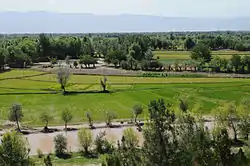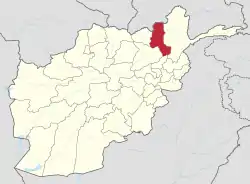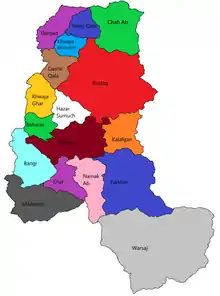Takhar Province
Takhar (Dari: تخار) is one of the thirty-four provinces of Afghanistan, located in the northeast of the country next to Tajikistan. It is surrounded by Badakhshan in the east, Panjshir in the south, and Baghlan and Kunduz in the west. The city of Taloqan serves as its capital.
Takhar
تخار | |
|---|---|
 View from atop a hill in Khawajah Bahawuddin, Takhar Province, Afghanistan. | |
 Map of Afghanistan with Takhar highlighted | |
| Coordinates (Capital): 36.7°N 69.8°E | |
| Country | Afghanistan |
| Capital | Taloqan |
| Government | |
| • Governor | Qari Mohammad Ismail Turkman[1] |
| • Deputy Governor | Haji Kazim[2] |
| • Police Chief | Habibullah Shakir [3] |
| Area | |
| • Total | 12,333 km2 (4,762 sq mi) |
| Population (2021)[4] | |
| • Total | 1,113,173 |
| • Density | 90/km2 (230/sq mi) |
| Time zone | UTC+4:30 (Afghanistan Time) |
| Main languages | Persian |
| Website | http://takhar.gov.af/en/ |
| Persian language | |
The province contains 17 districts, over 1,000 villages, and approximately 1,113,173 people,[4] which is multi-ethnic and mostly a rural society.[5]
The city was attacked during the 2021 Taliban offensive (which coincided with the withdrawal of United States troops).
On May 2, 2021, PiramQul Ziayi, the most influential anti-Taliban figure in Takhar, was assassinated in Rustaq district.[1]
Following the fall of several districts of Takhar to the Taliban [2], on June 20, 2021, a group of Takhar elders led by Mohibullah Noori, a Resistance leader, announced at a press conference in Kabul that will mobilize people resistance in support of security forces in Takhar. Mohibullah Noori led the group entered the Taloqan City on June 26, 2021 and united the Takhar commanders to resist against Taliban.[3]
The Taliban tried to take the city in July 2021, however the attack was repulsed. Later during the huge Taliban offensive Haji Agha Gul was killed by Taliban and Khair Mohammad Teymour injured and all forces, including provincial officials, retreated to the Versaj district. On August 8, 2021, the Taliban gained control of the province during the 2021 Taliban offensive. However, National Resistance Front fighters have still maintained a presence in the province.[6][7][8]
History
| History of Afghanistan |
|---|
 |
| Timeline |
|
Early history
16th to 20th centuries
Between the early 16th century and the mid-18th century, the territory was ruled by the Khanate of Bukhara.
It was given to Ahmad Shah Durrani by Murad Beg of Bukhara after a treaty of friendship was reached in or about 1750, and became part of the Durrani Empire. It was ruled by the Durranis followed by the Barakzai dynasty and was untouched by the British during the three Anglo-Afghan wars that were fought in the 19th and early 20th centuries.
1964–2001
It was established in 1964 when Qataghan Province was divided into three provinces: Baghlan, Kunduz and Takhar. During the 1980s Soviet–Afghan War, the area fell under the influence of Rabbani and Ahmad Shah Massoud. It was controlled by the Northern Alliance in the 1990s. It experienced some fighting between the Northern Alliance and the Taliban forces. Takhar holds notoriety as the location where Mujahideen Commander Ahmad Shah Massoud was assassinated on 9 September 2001 by suspected al-Qaeda agents.
2001–2015
International Security Assistance Force (ISAF) took over security responsibility of the area in the early 2000s, which was led by Germany. The province also began to see some developments and the establishment of Afghan National Security Forces (ANSF). In a small incident in July 2008, the Afghan National Police killed Mullah Usman when several armed Taliban militants under his command raided a police checkpoint in the Kalafgan district. This was the first time since the fall of Taliban regime in 2001 that the Taliban insurgents engaged police in this province. Mullah Usman was the most senior Taliban commander in the northeast region of Afghanistan, according to the Afghan Interior Ministry.[9]
In May 2009, Taliban insurgents fighting Afghan government attacked the Baharak district in Takhar province.[10] A bomb attack on 28 May 2011 killed General Shahjahan Noori, Mohammed Daud Daud and injured Governor Taqwa. Several German soldiers and Afghans were also killed.[11][12]
In April 2012, the water supply at the Rostaq district's school for girls was poisoned by unknown insurgents, sickening at least 140 Afghan schoolgirls and teachers ranging in age from 14 to 30, causing them to be hospitalized and some to partially lose consciousness, though there have been no deaths so far.[13]
2015 earthquake
On 26 October, the 7.5 Mw Hindu Kush earthquake shook northern Afghanistan with a maximum Mercalli intensity of VIII (Severe). This earthquake destroyed almost 30,000 homes, left several hundred dead, and more than 1,700 injured.[14]
Demographics


As of 2021, the total population of the province is about 1,113,173[4] which is mostly tribal and a rural society. The main inhabitants of Takhar province are Uzbeks, Tajiks and few Pashtuns.
District information
| District | Capital | Population[4] | Area | Number of villages and ethnic groups |
|---|---|---|---|---|
| Baharak | 35,552 | 231 km2 | 74 villages 80% Tajik 20% Uzbek.[15] | |
| Bangi | 40,419 | 566 km2 | 59 villages 90% Tajik.[16] | |
| Chah Ab | 91,767 | 764 km2 | 63 villages 85% Tajik.[17] | |
| Chal | 32,443 | 330.8 km2 | 58 villages. Uzbek, Tajik.[18] | |
| Darqad | 30,956 | 393 km2 | 34 villages 85% Uzbeks.[19] | |
| Dashti Qala | 36,769 | 280 km2 | 49 villages 85% uzbek[20] | |
| Farkhar | 53,998 | 1,214 km2 | 75 villages 99% Tajik.[21] | |
| Hazar Sumuch | 15,816 | 309 km2 | 28 villages Uzbeks.[22] | |
| Ishkamish | 67,860 | 806 km2 | 103 villages majority Uzbeks[23] | |
| Kalafgan | 40,554 | 479 km2 | 42 villages 95% Uzbeks.[24] | |
| Khwaja Bahauddin | 26,765 | 178.2 km2 | 25 villages Uzbek, Tajik, Pashtun.[25] | |
| Khwaja Ghar | 77,516 | 402 km2 | 62 villages 80% Tajik.[26] | |
| Namak Ab | 14,058 | 584 km2 | 28 villages 50% Tajik 50% Uzbek.[27] | |
| Rustaq | 189,495 | 1,939 km2 | 179 villages Majority Uzbek.[28] | |
| Taluqan | Taluqan | 263,800 | Majority Uzbek. | |
| Warsaj | 43,663 | 2705.3 km2 | 94 villages Majority Tajik.[29] | |
| Yangi Qala | 51,742 | 247 km2 | 64 villages 85% Uzbeks.[30] |
Economy
Agriculture and mining are the main industries of the province. Takhar has coal reserves of fairly good quality which are being exploited by hand in some villages and sold in the region. The local population considers gold the most relevant resource for the Province. Gold is being washed in Takhar River, and about 2 kg are being transported to the specific weekly markets in the city of Taloqan. Also the city is a main source of construction materials like: loam, sand, and different types of stones. Takhar province is known for its salt mountains and you can find large deposits of fine salt in the region. The Takcha Khanna salt mine is one of the growing number of salt supplier, for the population of Takhar and northern Afghanistan. While the mines offer economic opportunities in the region, the availability of iodized salt considerably reduces the prevalence of health problems related to iodine deficiency.
See also
- Tokharistan
- Taloqan
Footnotes
- کاکړ, جاويد هميم (14 March 2022). "سرپرست حکومت په وزارتونو، ولایتونو او قول اردو ګانو کې نوې ټاکنې وکړې".
- "جمهور - تعیینات جدید از سوی رهبر طالبان انجام شد". 14 March 2022.
- "د نږدې شلو ولایاتو لپاره نوي والیان او امنیې قوماندانان وټاکل شول". 7 November 2021.
- "Estimated Population of Afghanistan 2021-22" (PDF). National Statistic and Information Authority (NSIA). April 2021. Archived (PDF) from the original on 29 June 2021. Retrieved 21 June 2021.
- "Takhar provincial profile" (PDF). Archived from the original (PDF) on 1 December 2017. Retrieved 22 May 2012.
- Kohzad, Nilly (15 December 2021). "What Does the National Resistance Front of Afghanistan Have to Offer?". The Diplomat. Retrieved 19 December 2021.
- Filmer, Antonia (4 September 2021). "Resistance Front in Panjshir geared up for defending Afghanistan against Taliban". The Sunday Guardian. Retrieved 8 December 2021.
- Yousafzai, Shahabullah (24 November 2021). "Taliban's Takhar district governor killed in roadside explosion". Express Tribune. Retrieved 8 December 2021.
- "Takhar police kill Taliban commander"
- "Taliban attack district in NE Afghanistan". Military-world.net. 24 May 2009. Retrieved 22 May 2012.
- "Three German soldiers die in Afghan attack". Thepeninsulaqatar.com. 29 May 2011. Archived from the original on 31 May 2011. Retrieved 22 May 2012.
- Gambrell, Jon (29 May 2011). "Taliban suicide bomb hits Afghan governor's complex". Boston.com. Retrieved 7 January 2022.
- Masoud Popalzai, CNN (17 April 2012). "Extremists poison schoolgirls' water, Afghan officials say". CNN. Retrieved 22 May 2012.
- USGS. "M7.5 - 45 km E of Farkhar, Afghanistan". United States Geological Survey.
- "Baharak District" (PDF).
- "Bangi District" (PDF).
- "Chah Ab District" (PDF).
- "Chal District" (PDF).
- "Darqad District" (PDF).
- "Dasht e Qala Agha" (PDF).
- "Farkhar District" (PDF).
- "Hazar Smoch District" (PDF).
- ww1.mrrd-nabdp.org http://ww1.mrrd-nabdp.org/. Retrieved 14 August 2020.
{{cite web}}: Missing or empty|title=(help) - "Baharak District" (PDF).
- "Khwaja Bahawodin District" (PDF).
- "Khwaja Ghar" (PDF).
- "Namak Ab District" (PDF).
- "Rostaq Agha" (PDF).
- "Warsaj District" (PDF).
- "Yangi Qala" (PDF).
External links
- Naval Postgraduate School - Takhar Province
- Ministry of Rural Rehabilitation and Development - Takhar Province
- Defense Video & Imagery Distribution System - Takhar Province
- Takhar (pictures of Takhar province)